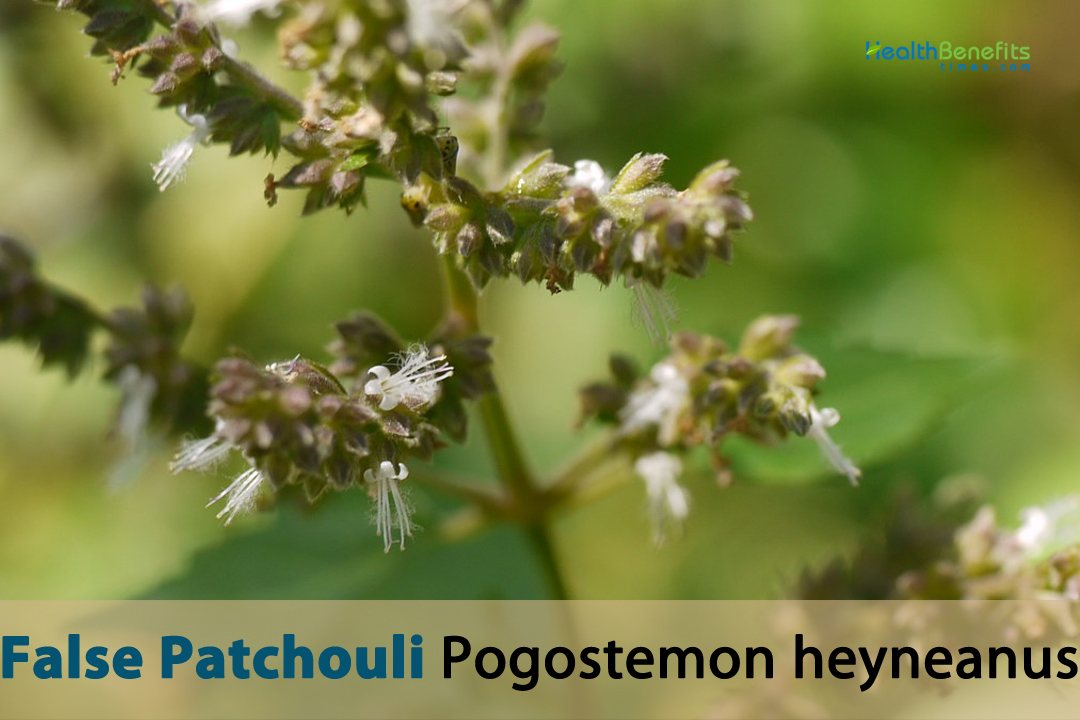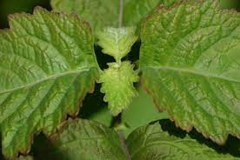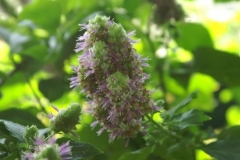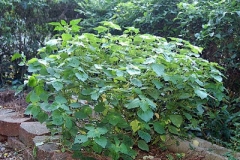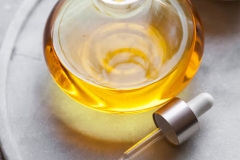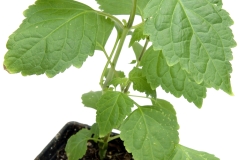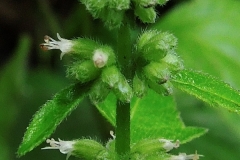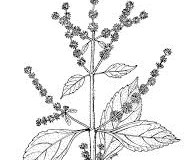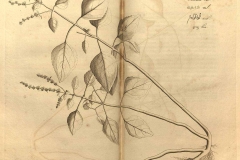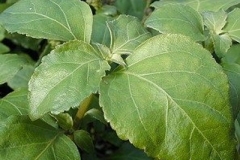| False Patchouli Quick Facts | |
|---|---|
| Name: | False Patchouli |
| Scientific Name: | Pogostemon heyneanus |
| Origin | Southeast Asia |
| Colors | Initially green turning to brown or tan when mature |
| Shapes | Small, roughly spherical or slightly flattened fruit |
| Major nutrients | • Vitamin A • Vitamin C • Vitamin B3 (niacin) • Vitamin B2 (riboflavin) • Minerals • Phytochemicals • Dietary Fiber |
| Health benefits | Digestive Aid, Menstrual Pain Relief, Fever Reduction, Wound Healing, Respiratory Health, Stomach Upset Relief, Pain Management, Hair Care, Skin Care, Cognitive Support, Blood Pressure Regulation, Relief from Insomnia, Aid for Insect Bites, Liver Support |
| Name | False Patchouli |
|---|---|
| Scientific Name | Pogostemon heyneanus |
| Native | Southeast Asia. Its natural range includes countries such as Indonesia, India, Malaysia, the Philippines, Thailand and other parts of Southeast Asia |
| Common Names | White Patchouli, Fragrant Indian Pogostemon, Scented Plectranthus, False Pogostemon, Malabar Patchouli, Light Patchouli, Dwarf Patchouli, Indian Patchouli, Vanilla Leaf, Light-leafed Pogostemon, Philippine Patchouli, Fragrant Plectranthus, Wild Patchouli, Baby Patchouli, Fragrant Spur Flower, Java Patchouli, Camphor Leaf, Sweet Patchouli |
| Name in Other Languages | Afrikaans: Vals Patchouli Arabic: Batshuli muzayaf (باتشولي مزيف), Al-Batchouli Al-Za’if (البتشولي الزائف) Armenian: Khorkurdayin Pachuli (Խորհուրդային Փաչուլի) Assamese: Mithya Pachuli (মিথ্যা পচুলি), Bhondo Pachouli, Xukloti (শুকলতি) Bengali: Osatya Peyachuli (অসত্য প্যাচুলি), False Patchouli (মিথ্যা প্যাচুলি), Mithya Peyachuli (মিথ্যা প্যাচুলি) Bhilali: Dohiri Pachouli Bhojpuri: Jhuth Pachauli (झूठ पचौली), Asalī Pachaulī (असली पचौली) Bhutanese: Drenpa Chodur Chuli (དྲན་པ་ཅོ་དུར་ཆུལི) Bhutia (Sikkimese): Dra Nya Pachouli Bulgarian: Falshiv Patchouli (Фалшив Patchouli) Burmese: Mocsawwang Aka (မိုးစောဝင်းအကီ) Chinese: Jiǎ lóng shé lán (假龙舌兰), Jiǎ guǎng huòxiāng (假廣藿香), Huo xiang Croatian: Lažni Patchouli Czech: Falešný Pačuli Danish: Falsk Patchouli Dogri: Nakko Pachouli Dutch: Valse Patchouli English: False Patchouli, Indian patchouli, Java patchouli Estonian: Vale Patchouli Fijian: Lewa Patchouli Filipino: Peke na Patchouli Finnish: Väärä Patchouli French: Patchouli Faux, Patchouli Garhwali: Ghodaru Garo: Chamak Pachouli Georgian: Zghari Pachuli (ზღარი პაჩული) German: Falscher Patchouli Gondi: Falti Pachouli Greek: Pseútiko Patsoulí (Ψεύτικο Πατσουλί), Pseudes Patsouli (Ψευδές Πατσουλί) Gujarati: False Patchouli (મૃગજૂ પેચુલી), Mona Pechuli (મોના પેચુલી), Kukardeen Pacholi (કુકરદીનો પચોલી), સુગંધી પાનડી (Sugandhi panadi) Hausa: Patchouli Mai Tafi Hebrew: Patchouli Mezuy (פטשולי מזוי) Hindi: False Patchouli (फॉल्स पैचूली) Hungarian: Hamis Patsuli Icelandic: Falskt Patchouli Indonesian: Patchouli Palsu Italian: Patchouli Falso Japanese: Nise no pachouri (偽のパチョウリ), Forusupachouri (フォルスパチョウリ) Javanese: Patchouli Palsu Kannada: False Patchouli (ಸುಳ್ಳಿನ ಪಚ್ಚುಲಿ), Suḷḷu Pacauli (ಸುಳ್ಳು ಪಚೌಲಿ), Falls Pachouli (ಫಾಲ್ಸ್ ಪಚೌಲಿ) Kashmiri: Jaali Pachouli (جعلی پچولی) Kazakh: Álsız Pachuli (Әлсіз Пачули) Khasi: Tliar Pachouli Khmer: Paat Pākhuulei Kaare (ផាត់ប៉ាកួលីការ៉ែ) Kodava: Kuni Pachouli Kokborok: Muikuli Konkani: Fhasko Patchouli, Falls Pachyuli (फाल्स पच्युली), paat (पात) Konyak Naga: Haku Pachouli Korku: Foyrati Pachouli Korean: Gajja Paechelli (가짜 패츌리) Kumaoni: Kanthap Kurukh: Birhar Pachouli Kyrgyz: Jalmau Pachuli (Жалмау Пачули) Ladakhi: Thongo Pachouli Lao: Kān Patchouli Thā Mư̄ (ການ Patchouli ຖ້າມື້) Latvian: Nepatiesais Pacūlijs Lithuanian: Netikras Pachulis Maithili: Mithya Pachaulī (मिथ्या पचौली) Malay: Pachuli Palsu, Pachouli Palsu Malayalam: False Patchouli (പൊമ്പി പച്ചുലി), Asathya Pacchūli (അസത്യ പച്ചൂലി), Kunthirikkam Manipuri: Suban Pachouri (সুবান পচৌরি) Marathi: False Patchouli (असत्य पॅचूली), Khōṭī Pæcūlī (खोटी पॅचूली), pach (पाच) Meitei: Thunap Pachouli Mishing: Sokuw Pachouli Mizo: Thlarau Mongolian: (Khudal Pachuli (Худал Пачули) Nagamese: Sakta Pachouli Nepali: Khota Paichauli (खोटा पैचौली), Pharajī paichaulī (फर्जी पैचौली), Jaali Pachouli (जाली पचौली) Norwegian: Falsk Patchouli Nyishi: Sulu Pachouli Odia: Jhootha Pachouli (ଝୂଠ ପଚୌଲୀ) Oriya: Mithya Pachuli (ମିଥ୍ୟ ପଚୁଳି) Pashto: Daghch Pachwli (دغږ پچولۍ) Polish: Fałszywy Paczuli Portuguese: Patchouli Falso, Oriza, Patchouli Punjabi: Jhūṭhē paicūlī (ਝੂਠੇ ਪੈਚੂਲੀ), False Patchouli (ਝੂਠਾ ਪੈਚੋਲੀ), Jhūṭhī Paicaulī (ਝੂਠੀ ਪੈਚੌਲੀ), Khota Pachouli (ਖੋਟਾ ਪੱਚੌਲੀ) Romanian: Patchouli Fals Russian: Lozhnyy pachuli (Ложный пачули) Sanskrit: Asalī Pacūli (असली पचूलि) Santali: Dhusardali Serbian: Lažni Patchouli (Лажни Пачули) Sindhi: Jaali Pachouli (جعلي پڇولي) Sinhala: Walu Pakuli (වල් පකුලි), Kollan kola (කොල්ලන් කොළ), Gan kollan kola (ගං කොල්ලන් කොළ ), Gas kollan kola (ගස් කොල්ලන් කොළ ) Slovenian: Lažni Patchouli Somali: Laab Patchouli Spanish: Pachulí Falso Sri Lankan: Kollan kola Sundanese: Palsu Patchouli Swahili: Patchouli Bandia, Uongo Patchouli Swedish: Falsk Patchouli Tagalog: Peke na Patchouli Tajik: Pachulii dorusti (Пачулии дорусти) Tamil: False Patchouli (பொய்யான பச்சுலி), Pombala pāṭcūli (பொம்பள பாட்சூலி), Katir paccai, Kannokkikyacceti, Katirppaccai Tangkhul Naga: Phuinao Pachouli, katir-p-paccai (கதிர்ப்பச்சை) Telugu: False Patchouli (అసత్య పచులి), Nirādara Paculi (నిరాదర పచులి) Thai: False Patchouli (พัชรีเทียม), Pathchūlī̀ thī̀em (พัชชูลี่เทียม), Paat-chuu-lîi thîiam (ปาตชูลี่เทียม) Tibetan: Namshu’i Gal-Drer Lo-Ba (རྣམ་གཞུའི་སྒལ་འབྲེལ་བློ་བ) Tulu: Suḷḷu Paculi (ಸುಳ್ಳು ಪಚೂಲಿ) Turkish: Sahte Paçuli Ukrainian: Falshivyi Pachuli (Фальшивий Пачулі), Pidroblenyi Pachuli (Підроблений Пачулі) Urdu: False Patchouli (جعلی پیچولی), Jaali Paichauli (جعلی پیچولی) Vietnamese: Patchouli Giả Yoruba: Patchouli Alase Zulu: Isifuba sokuqala Patchouli |
| Plant Growth Habit | Large, erect or ascending, straggling, branched, hairy , evergreen herbaceous perennial plant |
| Growing Climates | Thickets, old clearings, coconut plantations, tropical Rainforests, tropical woodlands, forested areas, edges of clearings, roadsides, riverbanks, stream sides, upland areas and on hillsides |
| Soil | Well-draining, loamy or sandy soil. It prefers a slightly acidic to neutral pH level |
| Plant Size | About 2 to 3 feet (60 to 90 centimeters) when mature |
| Root | Fibrous root system |
| Stem | Herbaceous stem that is non-woody, square, green and flexible |
| Bark | Does not have a true bark |
| Leaf | Leaves are very aromatic, somewhat smooth, lance-shaped or ovate, 5 to 11 cm long with serrated or slightly toothed edges |
| Flowering season | August to October |
| Flower | Small, tubular shaped flowers that can vary in color, including white, lavender, or pale purple, with a narrow, elongated structure that flares open at the top into a small, five-lobed corolla |
| Fruit Shape & Size | Typically small, roughly spherical or slightly flattened fruit, resembling tiny capsules measuring few millimeters in diameter |
| Fruit Color | Initially green turning to brown or tan when mature |
| Fruit Skin | Thin, papery and fragile |
| Seed | Generally small, flattened, and oval or kidney-shaped ranging from a few mm to a cm long |
| Flavor/Aroma | Rich, earthy, and musky scent, much like true patchouli |
| Plant Parts Used | Leaves and essential oil |
| Propagation | By seeds, stem cutting, division, air layering and offsets |
| Lifespan | For 20 years or more |
| Season | October to December |
| Varieties |
|
| Major Nutrition |
|
| Available Forms |
|
| Health benefits |
|
Plant Description
At maturity, False Patchouli is a sizable, erect or ascending, straggling, branched, pubescent herbaceous perennial that measures between 60 and 90 centimeters (2 to 3 feet) in height. Tightested areas, abandoned coconut plantations, tropical rainforests, tropical woodlands, forested regions, clearing margins, roadside vegetation, riverbanks, stream banks, upland regions, and hillsides are all habitats where this plant can be observed in bloom. The plant prefers sandy or loamy soil with adequate drainage. It has a minor preference for an acidic to neutral pH range. Particularly in India, it is extensively cultivated for its aromatic foliage, albeit on a relatively modest magnitude. The majority of its essential oil cultivation has ceased. The foliage is employed in the manufacturing process of perfumes, incense, and essential oils for their aromatic qualities. Sometimes, they are utilized in traditional medicine for their possible medicinal properties.
Appropriate growing environment for False Patchouli
False Patchouli is a tropical and subtropical herb that thrives in warm and humid environments. To grow False Patchouli successfully, you need to provide it with the appropriate growing conditions. Here’s a guide to the ideal environment for cultivating False Patchouli:
- Climate: The contrary Patchouli thrives in subtropical to tropical environments that are mild. It flourishes in temperatures between 21°C and 32°C, or 70°F and 90°F. Frost intolerance and sensitivity to low temperatures characterize it.
- Sunlight: Allow False Patchouli to be exposed to direct to partial sunlight. Daily exposure to a minimum of four to six hours of direct sunlight is advantageous. Nevertheless, it can survive in partial shade, particularly when the temperature reaches its peak.
- Soil: False Patchouli should be planted in loamy, calcareous, or well-draining soil. Its ideal pH range is mildly acidic to neutral, between 6.0 and 7.0. Proper drainage is essential for preventing root entrapment.
- Watering: False Patchouli needs consistent irrigation to maintain a moist yet not saturated soil. Before wetting again, ensure that the soil surface has slightly dried. In periods of high temperature or drought, it may be necessary to apply water more frequently.
- Humidity: Extremely high levels of humidity are required to produce false patchouli. Aim for relative humidity levels of 50 to 80 percent in order to replicate its native tropical habitat. Utilize a humidity receptacle or a humidifier to ensure adequate moisture levels when cultivating it indoors.
- Fertilization: During the growing season (spring and summer), apply a balanced, slow-release fertilizer or an organic alternative to the False Patchouli. Over fertilization should be avoided, as it may result in leaf proliferation to the detriment of essential oils.
- Container Growing: When cultivating False Patchouli in containers, ensure that the potting mix is well-draining and that the container has adequate drainage openings. Ensure that sufficient sunlight reaches the container.
- Pruning: Remove False Harvesting leaves of patchouli on a regular basis promotes bushier development and serves aromatic and medicinal functions. Remove the growing ends with a pinch to encourage branching.
- Protection from Cold: When residing in an area prone to sporadic cold periods, safeguard False Patchouli against frost and low temperatures. Transfer potted plants indoors, and for outdoor plants, provide frost protection.
- Spacing: Maintain a spacing of 12 to 18 inches between multiple False Patchouli plants when planting them in the ground to ensure sufficient air circulation and prevent congestion.
- Pest and Disease Management: Observe for prevalent parasites such as aphids and spider mites. Immediate treatment of infestations with suitable remedies is required. In general, False Patchouli exhibits resistance to a host of maladies.
- Harvesting Leaves: It is customary to harvest the mature aromatic leaves a few months subsequent to the date of sowing. Typically, this is accomplished by removing the foliage from the plant. Remove no more than one-third of the plant at a time with caution.
Roots
False Patchouli is characterized by its fibrous root structure. This indicates that the roots are composed of numerous thread-like structures that protrude in diverse directions from the plant’s base. In addition to providing the plant with stability in the soil, these fibrous roots absorb water and nutrients. False Patchouli typically has a shallow root system, with the majority of its roots residing in the upper soil strata. By means of these superficial roots, the plant is capable of effectively acquiring moisture and nutrients from the uppermost layer of soil. Branching may be observed in the roots, whereby smaller lateral roots emanate from the primary root structures. By increasing the surface area of the roots, this branching improves the plant’s ability to assimilate water and nutrients.
Similar to numerous herbaceous plants, the surface of the roots of False Patchouli may be covered with fine root filaments. The aforementioned minuscule filaments serve to augment the plant’s aptitude for absorbing soil-borne water and minerals. The root system is adapted to the natural environment of the plant, which is frequently tropical soils with good drainage. The fibrous and superficial root system is highly compatible with the soil conditions, as it enables efficient nutrient absorption.
Stem
Due to its vegetal stem, False Patchouli is devoid of the rigid, lignified tissues that are characteristic of woody plants (e.g., trees and shrubs). Typically, the stem is flexible and green in color. Similar to numerous mint family members (Lamiaceae), False Patchouli possesses a square stem. The stem’s configuration of vascular tissues (bundles) gives rise to its square form. This characteristic sets plants in this family apart. There are internodes and nodes comprising the stem. Nodes are the anatomical locations along the stem that give rise to leaves, branches, or blossoms. Internodes refer to the stem segments that exist between nodes. Generally, leaves are appended at the nodes. True Patchouli has the potential to develop into a highly branched specimen, particularly as it reaches maturity. From the leaf axils (the angle between the leaf and the stem) or from a greater elevation on the main stem, branches may emerge.
Bark
False Patchouli is characterized by its vegetative stem, which is flexible, non-woody, and generally green in color. Secondary growth is not present in this particular variety of stem, which is what causes the development of bark in organic plants. False Patchouli, similar to numerous plants in the Lamiaceae family of mint, possesses a square stem. This square shape is a distinguishing characteristic of plants in this family and results from the arrangement of vascular tissues in the stem.
Leaves
The leaves of false patchouli are customarily arranged in the opposite direction. This indicates that despite being affixed to the stem at the same level, pairs of leaves are arranged in opposition to one another, with one leaf directly across from the other. This leaf arrangement in the opposite direction is prevalent on numerous plants in the mint family. While leaf shapes may differ, they are typically ovate or lance-shaped (resembling eggs). Their edges might be serrated or faintly toothed. Although leaves may differ in size, they are typically of a moderate proportions, spanning from a few centimeters to several centimeters in length. Specific species and environmental conditions are potential determinants of the leaf’s size and shape.
The typical hue of False Patchouli leaves is dark green, a trait shared by numerous plants that thrive in tropical and subtropical zones. The upper surfaces of the leaves are glossy and smooth, whereas the lower surfaces may be faintly textured or hairy. The texture may exhibit variation across distinct species and cultivars. Similar to the majority of dicotyledonous plants, the leaves of False Patchouli are veined to distribute nutrients, carbohydrates, and water. Generally, the veins are more conspicuous on the underside of the leaf. The leaves are aromatic and comprise essential compounds that are responsible for imparting their distinctive fragrance. The leaf aromatic compounds are what impart the herb its characteristic fragrance, which is frequently linked to aromatherapy and fragrances. Nodes are anatomical locations along the stem from which leaves, branches, or flowers emanate. From these nodes, leaves are affixed to the stem. At the nodes, the leaves of False Patchouli are positioned in direct opposition to one another.
Flowers
Flowers of False Patchouli are typically arranged in clusters or spires. These inflorescences may comprise numerous diminutive blossoms arranged along a central stem and may exhibit variation in size. Typically, the dimensions of the individual blossoms range from a few millimeters to one centimeter. The flowers possess a tubular morphology, characterized by a slender, elongated structure that appoints to a diminutive, five-lobed corolla. The corolla frequently possesses two lips, which is a prevalent characteristic observed in the mint family. Variation in flower color is characteristic of numerous species and cultivars. Phallic, lavender, white, and purple hues are typical of flowers. The coloration may vary depending on the cultivar or environmental conditions during cultivation.
Surrounding the base of the flower is a tubular calyx comprised of sepals. Whether green or pigmented, the calyx can vary by variety. The calyx frequently possess a segmented morphology, characterized by a variable number of teeth or lobes. The most visible portion of the flower is the corolla, which may be colored more vividly than the calyx. It consists of five lobes that are organized in a two-lipped configuration. Typically, there are two lobes on the upper lip and three lobes on the lower lip. Four stamens, which are male reproductive organs, are commonly found within the flower and extend beyond the corolla. There may be anthers on the filaments that contain pollen. The female reproductive organ, the pistil, is composed of a solitary style affixed with a stigma that facilitates pollen reception. As an individual belonging to the Lamiaceae family, False Patchouli frequently possesses a stigma with two lobes. The fragrance of False Patchouli flowers may be aromatic or agreeable, with the degree of intensity potentially differing between distinct cultivars or species. The aesthetic allure of the flowers in gardens is enhanced by their fragrance.
Fruits
False Patchouli generates indehiscent, desiccated fruits; thus, the fruits remain closed at maturity, preventing the release of their seeds. Conversely, they maintain their closure. Generally, the fruits are round and little in size. They may have a slightly compressed, spherical shape or resemble minute capsules. Fruits typically gauge a few millimeters in diameter, which is a relatively small dimension. Their size and visibility are generally not noticeable. When mature, the fruits are frequently brown or tan in color, although this can differ. The particular hue may be contingent upon variables including the species and the developmental stage of the fruit. In addition to its dry, paper-like exterior, this fruit lacks the fleshy and succulent qualities that are characteristic of the majority of fruit varieties. It is frequently fragile and slender.
Seeds
In general, false patchouli seeds are oval or kidney-shaped, flattened, and tiny. Their appearance is somewhat flattened, enabling them to be contained within the desiccated, papery fruit. In general, False Patchouli seeds are of a diminutive stature, with an approximate length of one centimeter or so, with variations among species and varieties. Seeds are frequently brown or a dark brown hue. While minor variations may occur in the specific shade, the overall tone is earth-toned. Although seeds may have a smooth or faintly textured surface, they are not typically ridged or highly textured.
Varieties of False Patchouli
False Patchouli is a plant species that includes several varieties and cultivars, each with its unique characteristics, fragrance profiles, and growth habits. These varieties may vary in leaf shape, flower color, and growth forms. Here are some of the known varieties and cultivars of False Patchouli:
- Green False Patchouli (Pogostemon cablin): One of the most widely recognized and frequently cultivated varieties of False Patchouli. Patchouli is frequently denoted by the common name “Patchouli” and is renowned for the production of Patchouli essential oil from its aromatic foliage. It bears aromatic, sizable foliage and violet-white blossoms.
- Java Patchouli (Pogostemon javanicus): This variety of False Patchouli, which is indigenous to Java, is utilized for its aromatic and traditional medicinal qualities. It is characterized by its diminutive, lance-shaped foliage and its white to pale purple blossoms.
- Singapore Patchouli (Pogostemon parviflorus): This cultivar is indigenous to Singapore and its leaves are renowned for their aroma. In contrast to other cultivars, it exhibits comparatively diminutive foliage and bestows white or pale lavender blossoms.
- Malabar False Patchouli (Pogostemon plectranthoides): This variety, which is native to the Malabar Coast in India, is utilized in traditional medicine and perfumery for its aromatic foliage. The plant exhibits lance-shaped, slender foliage and bears white or lavender blossoms.
- Malaysian Patchouli (Pogostemon heyneanus var. malaccensis): Native to Malaysia, this variety is highly regarded for its aromatic qualities. Its foliage is lance-shaped, and its blossoms range in hue from lavender to purple.
- Sumatran Patchouli (Pogostemon heyneanus var. sumatranus): This variety, indigenous to Sumatra, Indonesia, is cultivated for its essential oil and fragrant foliage. The plant exhibits lance-shaped foliage and purple-white blossoms.
- Sulawesi Patchouli (Pogostemon heyneanus var. celebicus): This variety, which is native to Sulawesi, Indonesia, is distinguished by its fragrant foliage. The plant displays lance-shaped, slender leaves and emits flowers ranging in color from lavender to purple.
- Vietnamese Patchouli (Pogostemon cablin var. subcordatus): This variety, indigenous to Vietnam, is utilized in the production of essential oil and for its aromatic properties. Its blossoms range in hue from lavender to purple and have leaves that resemble hearts.
- Indian Patchouli (Pogostemon heyneanus var. heyneanus): Native to India, this variety is cultivated for the production of essential oil and aromatic foliage. The plant exhibits lance-shaped foliage and purple-white blossoms.
- Philippine Patchouli (Pogostemon heyneanus var. luzonensis): This cultivar, which is native to the Philippines, is renowned for its aromatic foliage. Its foliage is lance-shaped, and its blossoms range in hue from lavender to purple.
Health benefits of False Patchouli herb
False Patchouli also known as Indian Patchouli or White Patchouli, is an herb with a variety of potential health benefits when used in traditional medicine and herbal remedies. Here are detailed health benefits of False Patchouli herb
1. Anti-Inflammatory Properties
False Patchouli comprises chemical constituents that exhibit anti-inflammatory properties. Anti-inflammatory properties may render it advantageous in the treatment of ailments such as arthritis, joint pain, and muscle fatigue.
2. Digestive Aid
False Patchouli has historically been employed to promote digestive health. It potentially provides relief from gas, bloating, and gastritis. It can be prepared and consumed as an infusion or herbal tea, both of which aid digestion.
3. Diuretic Effects
Due to its diuretic characteristics, the herb has the ability to induce an increase in urine output. This may aid in the elimination of impurities, the reduction of water retention, and the maintenance of healthy kidneys.
4. Menstrual Pain Relief
False Patchouli is utilized by some women to alleviate period cramping and discomfort. It is possible that its muscle-relaxing properties could assist in alleviating the severity of menstrual discomfort.
5. Fever Reduction
Historically, False Patchouli has been utilized to reduce fever. It may assist in reducing body temperature during febrile illnesses due to its febrifuge properties.
6. Wound Healing
Utilizing infused oils or topical applications of False Patchouli, including poultices, can promote wound healing through the inhibition of infections and facilitation of tissue regeneration.
7. Detoxification Support
By encouraging contaminant elimination via increased urination, False Patchouli might support the body’s natural detoxification processes.
8. Respiratory Health
The herb possesses the potential to alleviate respiratory ailments such as bronchitis and wheezing. It has the potential to mitigate airway obstruction and decrease wheezing.
9. Antioxidant Benefits
Antioxidants present in false patchouli have the potential to mitigate oxidative stress and the associated risk of chronic diseases by battling free radicals.
10. Stomach Upset Relief
Ingestion of False Patchouli decoctions or tea may alleviate gastrointestinal distress, such as diarrhea and vertigo.
11. Antispasmodic Properties
The antispasmodic properties of False Patchouli can alleviate cramping and muscle spasms throughout the body.
12. Pain Management
Incorporated into natural pain management regimens, the herb might provide general analgesic effects.
13. Antibacterial Effects
Several studies have indicated that False Patchouli may have antibacterial properties, which could prove advantageous in the fight against a wide range of bacterial infections.
14. Hair Care
Occasional use of infusions containing False Patchouli leaves as natural hair rinses to improve hair health and sheen.
15. Anti-Anxiety and Mood Enhancement
Balancing and elevating one’s mood, False Patchouli’s tranquil fragrance may exert such effects. Aromatherapy occasionally employs it to mitigate symptoms of anxiety and tension.
16. Skin Care
By applying False Patchouli topically to the skin, a variety of skin concerns can be resolved. It promotes a clearer complexion, reduces inflammation, and aids in the relief of skin irritations.
17. Antifungal Properties
Antifungal properties have been observed in False Patchouli, which may have therapeutic implications for fungal skin infections such as athlete’s foot or ringworm.
18. Immune System Support
Although not intended as a replacement for medical intervention, False Patchouli might provide immune system support by aiding the body in combating infections and diseases.
19. Aphrodisiac
False Patchouli has been linked to aphrodisiac attributes in certain cultural contexts, where it is thought to elicit desire and augment intimacy.
20. Antiviral Properties
Antiviral properties may be present in False Patchouli, which could prove advantageous in the fight against viral infections. It has the potential to enhance the body’s immune system’s capacity to combat pathogens.
21. Anti-Aging Effects
Antioxidants present in False Patchouli can prevent free radical damage to the epidermis, thereby assisting in the prevention of premature aging. This could potentially enhance one’s youthful aesthetic.
22. Cognitive Support
Certain advocates propose that the fragrance of False Patchouli might possess cognitive advantages, including the potential to augment concentration and focus. Aromatherapy may employ it to promote mental clarity.
23. Blood Pressure Regulation
Initial investigations indicate that False Patchouli might exhibit a moderate hypotensive effect, which, when utilized under medical supervision, could potentially aid in the reduction of hypertension.
24. Anti-Allergic Properties
Potential anti-allergic properties of False Patchouli include the ability to alleviate allergy symptoms like sneezing, rhinorrhea, and pruritus of the eyes.
25. Anti-Asthmatic
As an herbal remedy, False Patchouli is utilized by some individuals to alleviate asthma symptoms. It has the potential to alleviate breathing difficulties and soothe bronchial muscles.
26. Anti-Cancer Potential
Additional research is warranted; however, preliminary findings suggest that specific compounds present in False Patchouli might possess anticancer attributes, thereby impeding the proliferation of malignant cells.
27. Anti-Scarring
A topically applied formulation of the herb may aid in the reduction of scarring and keloids. It potentially promotes the healing process and inhibits the formation of scar tissue.
28. Relief from Insomnia
Individuals distressing from insomnia and sleep disturbances might benefit from the sedative and calming properties of False Patchouli.
29. Antipyretic Effects
Potential antipyretic properties of False Patchouli could aid in the reduction of fever and the alleviation of related symptoms.
30. Aid for Insect Bites
The administration of False Patchouli topically has the potential to alleviate the itching and distress induced by insect bites or stings.
31. Liver Support
False Patchouli is utilized in some traditional practices as a liver tonic to promote liver health and function.
Ayurvedic Benefits
- Malays administered a root decoction to treat dropsy.
- Coughs and asthma are also treated with decoction.
- A leaf poultice is applied topically to treat sores, headaches, jaundice, and bilious fevers.
- Pyorrhea, halitosis, anorexia, dyspepsia, flatulence, diarrhea, vomiting, abscesses, urinary tract diseases, abscesses, and cardiac disease are all treated with it in Ayurveda.
- In Malaya, rheumatism-treating roots are used to make lotion.
- Sternutatory pulverized leaves are utilized in Sri Lanka, similar to snuff.
- According to the Kuruma communities of Kerela, India, wounds are treated with a mixture of whole plant ash and mustard oil.
Culinary uses of False Patchouli herb
False Patchouli, while primarily known for its medicinal and aromatic uses, is not commonly used as a culinary herb in the same way as some other herbs like basil, thyme, or oregano. However, in some cultures, it is occasionally used in cooking for its unique flavor. Here are some culinary uses of False Patchouli:
- Flavoring Agent: Particularly, the leaves may be utilized as a flavoring agent. The leaves possess a discernible, earthy, and mildly peppery taste, accompanied by undertones of cinnamon and mint. When used sparingly, it imparts a distinctive flavor and aroma to food.
- Tea Infusion: Dried leaves may be incorporated into botanical teas. The tea is renowned for its aromatic and calming attributes. For a more complex flavor, it may be ingested as a standalone infusion or blended with other herbs.
- Condiments and Seasonings: As a condiment or seasoning, leaves are finely chopped or pulverized into a paste in some culinary traditions. This can impart complexity and depth to stews, sauces, and curries.
- Baked Goods: Upon desiccation and subsequent grinding into a powder, False Patchouli leaves may be integrated into baked products such as bread, cakes, and cookies. A distinctive and fragrant flavor can be imparted to these confections.
- Infused Oils and Vinegars: Oils and vinegars infused with False Patchouli leaves can be utilized as flavoring agents in marinades, salad dressings, and other culinary preparations.
- Sauces and Gravies: By using the leaves, one can enhance the flavor of sauces and gravies. A minimal amount may be utilized in order to augment the overall flavor profile of the dish.
- Cocktail and Beverage Garnish: As a garnish, leaves may be utilized in cocktails and non-alcoholic beverages. Their aromatic properties can augment the beverage’s sensory experience.
- Ethnic and Regional Cuisine: Traditional dishes in some regions, especially Southeast Asia, incorporate False Patchouli for its distinctive and pungent flavor. Its application is frequently restricted to particular regional menus and might not be pervasive.
- Herbal Infused Butter or Ghee: The fronds of false patchouli may be infused into ghee or butter. When the butter or ghee has melted, incorporate the False Patchouli leaves. After steeping the herb in the heated lard, proceed to strain it. Powered by the infusion, the butter or ghee may be drizzled over prepared dishes to impart a distinctive aroma or utilized as a flavorful base for sautéed vegetables.
- Rice and Grain Dishes: By incorporating False Patchouli into rice and grain preparations such as pilaf or risotto, one can introduce its subtle peppery and earthy essence. Incorporate a small quantity of dried False Patchouli or a few leaves into the cooking liquid designated for the cereals.
- Soup and Broth: For their aromatic properties, False Patchouli leaves are utilized in stews and broths in some culinary traditions. By adding them to the simmering liquid, their distinct flavor can be infused into the broth.
- Herbal Rubs and Marinades: Incorporating ground or finely minced False Patchouli leaves into marinades and spice rubs for meats, fish, or vegetables is possible. They can impart complexity and depth to roasted or grilled dishes.
- Scented Desserts: Dessert items that can be flavored with False Patchouli include custards, puddings, and ice creams. To impart aromatic qualities to the milk or cream utilized in the confection recipe, infuse it with the herb.
- Herbal Vinegar: By steeping leaves in vinegar, one can produce herbal vinegar. This vinegar with a distinct flavor can be utilized as a condiment, marinate, or salad dressing.
- Herbal Salt: Sea salt is combined with coarsely chopped or ground leaves to produce herbal salt. This aromatic salt can be used to enhance the flavor of a variety of dishes.
- Herbal Honey: Honey can be infused with False Patchouli leaves to produce an exceptional botanical sweetener. This ingredient possesses versatile applications, including tea sweetening, confection drizzle, and salad dressing.
- Herbal Syrups and Liqueurs: Herbal liqueurs and syrups can be produced by steeping the leaves in simple syrup or alcohol. These can be utilized as enhancing agents for desserts or to create one-of-a-kind cocktails.
- Herbal Tisanes and Cordials: It is possible to prepare herbal tisanes (herbal beverages) or cordials from the leaves. For calming beverages that possess a unique scent, steep the leaves in heated water or alcohol, respectively.
Different uses of False Patchouli
False Patchouli is a versatile herb with various uses, including medicinal, aromatic, and practical applications. Here are different uses of False Patchouli herb:
- Aromatherapy: In aromatherapy, the aromatic leaves of False Patchouli are frequently employed to establish a tranquil and firmly established ambiance. Its pleasant, earthy aroma promotes relaxation and aids in the reduction of tension and anxiety.
- Essential Oil Production: The essential oil is extracted from false patchouli foliage. Due to its woodsy, opulent scent, the essential oil is utilized in aromatherapy and perfumery. It is frequently used as a base element in fragrances.
- Aromatic Potpourri: By incorporating dried false patchouli leaves into potpourri blends, one can produce a decorative and aromatic concoction that can be used to fragrance closets and rooms.
- Insect Repellent: It is hypothesized that the potent fragrance of False Patchouli functions as an innate insect repellent. Utilize dried leaves or essential oil as an ingredient in homemade repellent sprays or to ward off vermin from entering closets.
- Crafts and Decorations: Dried False Patchouli leaves are utilized in the creation of wreaths, potpourri containers, and other ornamental objects.
- Natural Dye: As a natural dye, the leaves of False Patchouli can be utilized to imbue textiles and fabrics with brown and green hues.
- Spiritual and Ritual Uses: Certain cultures have incorporated False Patchouli into their spiritual and ritual practices due to its purported grounding and soothing attributes. It is suitable for use in cleansing ceremonies and as incense.
- Scented Products: False Patchouli is employed in the formulation of scented candles, perfumes, lotions, and air fresheners due to its aromatic properties.
- Scented Candles and Potpourri Sachets: In order to establish a serene and agreeable atmosphere within residences, perfumed candles and potpourri sachets frequently incorporate the aromatic foliage of False Patchouli.
- Natural Air Freshener: By placing dried False Patchouli leaves in cabinets, drawers, or rooms, one can impart a subtle, earthy fragrance and naturally purify the air.
- Perfumery: Essential oil extracted from False Patchouli is utilized as a base note to impart fragrances with profundity and fixative properties.
- Bath Products: For its aromatic and calming attributes, False Patchouli essential oil is incorporated into bath salts, bath bombs, and bath oils, thereby enhancing the overall bathing experience.
- Hair Care Products: Certain hair care products, including conditioners and shampoos, contain False Patchouli essential oil due to its pleasing aroma and possible health benefits for the scalp.
- Floral Arrangements: To impart an earthy and aromatic quality to floral arrangements and garlands, one may incorporate dried False Patchouli leaves.
- Natural Repellent: By positioning sachets or dried leaves of False Patchouli in areas where these insects are prevalent, it is possible to repel them. This includes moths and ants.
- Sachets and Potpourri Gifts: Dried False Patchouli leaves may be presented as considerate and fragrant presents in sachets or canisters.
- Herbal Baths: By incorporating dried False Patchouli leaves into a bath, one can create an aromatic and calming bathing environment.
- Religious and Spiritual Practices: False Patchouli may be employed as an aromatic offering or incense in certain religious and spiritual customs and ceremonies.
- Natural Cleaning Products: In addition to imparting a pleasing fragrance, false patchouli essential oil may also possess antibacterial properties.
- Pillow and Linen Sachets: By placing sachets containing dehydrated False Patchouli leaves in mattresses or linens, one can imbue them with a delicate and soothing aroma.
- Crafting and DIY Projects: Dried False Patchouli leaves can be utilized by crafters and do-it-yourselfers in a variety of projects, including the creation of herbal wreaths, ornaments, and handcrafted cards.
Side effects of False Patchouli
False Patchouli is generally considered safe for most people when used in moderation and according to recommended guidelines. However, like any herb or natural remedy, it can potentially have side effects or interactions with certain individuals. Here are some potential side effects and considerations when using False Patchouli:
- Skin Irritation: Undiluted, the highly concentrated essential oil of False Patchouli may cause skin irritation. Before administering essential oil topically, it is crucial to dilute it appropriately and conduct a patch test to determine skin sensitivity.
- Allergic Reactions: A few people might develop an allergy to False Patchouli or its constituent essential oil. Allergic reactions may manifest as respiratory symptoms or skin lesions. Eliminate use without delay if an allergy is suspected.
- Photosensitivity: Patchouli oil and other essential oils may increase the skin’s sensitivity to sunlight, thereby heightening the risk of sunburn. It is advisable to prevent direct sunlight exposure following the application of undiluted essential oil to the epidermis.
- Gastrointestinal Upset: Seldom may the ingestion of False Patchouli in large quantities or as a tea result in adverse gastrointestinal effects such as vertigo, vomiting, or diarrhea.
- Pregnancy and Breastfeeding: Regarding the safety of False Patchouli during pregnancy and lactation, information is limited. Before using it, expectant and nursing women are generally advised to consult a healthcare professional.
- Drug Interactions: Certain medications may interact negatively with False Patchouli. It is prudent to consult your healthcare provider prior to using this medicinal product if you are currently taking prescription medications or have any underlying health conditions.
- Liver Health: Traditional applications of Patchouli have incorporated its hepatotoxic properties. Although it is generally regarded as safe, those with hepatic conditions should exercise caution when using it and consult a physician if uncertain.
- Respiratory Irritation: Direct inhalation of concentrated patchouli essential oil from the bottle may result in irritation of the respiratory system. Avoid protracted inhalation and diffuse the oil in a well-ventilated area for optimal results.
- Avoiding Internal Use: Although False Patchouli leaves are occasionally incorporated into teas and prepared dishes, it is not advisable to consume them in excess. It is strongly discouraged to consume the essential oil without seeking the advice of a certified aroma therapist or healthcare practitioner.
- Hypotensive Effects: Patchouli may have a moderate hypotensive effect, potentially resulting in a reduction of blood pressure, according to some studies. If you have low blood pressure, consult your physician if you observe significant changes in your blood pressure while using this medication.
References:
http://www.stuartxchange.com/Kadlum.html
https://www.flowersofindia.net/catalog/slides/False%20Patchouli.html
https://indiabiodiversity.org/species/show/251249
http://www.instituteofayurveda.org/plants/plants_detail.php?i=732&s=Local_name
https://tropical.theferns.info/viewtropical.php?id=Pogostemon+heyneanus


